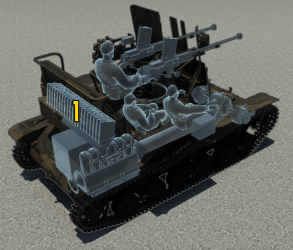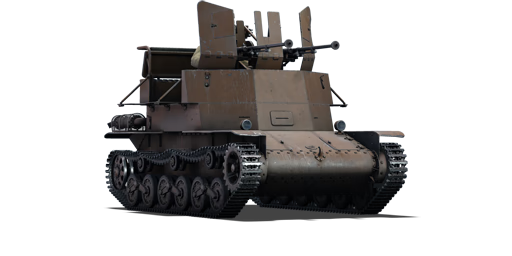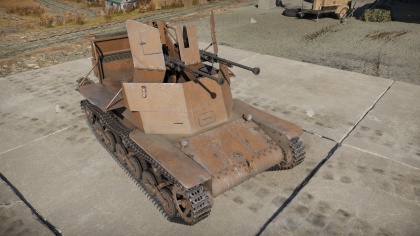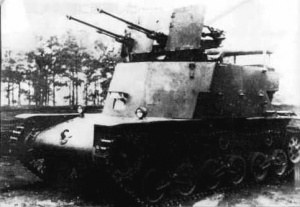So-Ki
Contents
Description
The So-Ki is a rank II Japanese self-propelled anti-aircraft gun
with a battle rating of 3.0 (AB/RB/SB). It was introduced along with the entire Japanese Ground Forces tree in Update 1.65 "Way of the Samurai".
This anti-aircraft vehicle features dual Type 98 20 mm cannons which have high-velocity capability and great mobility.
General info
Survivability and armour
Due to the lackluster armour, literally anything can destroy the So-Ki. Enemies armed with .50 cals - tanks and planes - are particularly deadly, as they can pierce through the weak armour with no problem. Destroying this tank is easy, with a shot slightly to the right of the driver's hatch for a one-shot to knock out both crew members in the hull.
Armour type:
- Rolled homogeneous armour
| Armour | Front | Sides | Rear | Roof |
|---|---|---|---|---|
| Hull | 16 mm (16-19°) Front plate 16 mm (11-72°) Front glacis 16 mm (29-48°) Lower glacis |
12 mm | 10 mm (12-51°) | 9 mm |
| Turret | 8 mm (10-14°) | N/A | N/A | N/A |
Notes:
- Suspension wheels and tracks are both 15 mm thick.
Mobility
This tank is quite fast, being built off of the Type 98 Ke-Ni, so use this blistering speed to your advantage.
| Mobility characteristic | ||
|---|---|---|
| Weight (tons) | Add-on Armor weight (tons) |
Max speed (km/h) |
| 7.0 | N/A | 49 (AB) |
| 45 (RB/SB) | ||
| Engine power (horsepower) | ||
| Mode | Stock | Upgraded |
| Arcade | 136 | 168 |
| Realistic/Simulator | 115 | 130 |
| Power-to-weight ratio (hp/ton) | ||
| Mode | Stock | Upgraded |
| Arcade | 19.43 | 24.00 |
| Realistic/Simulator | 16.43 | 18.57 |
Armaments
Main armament
Double the guns means double the difficulty enemy aircraft will have with dealing with you, so be sure to aim for engines and at the centre of planes - your exposed cabin means that planes will often try to dive you, hoping to score an air-to-ground knockout - give them a nasty surprise by filling their engines with Type 100 HE-T shells. That being said, always, always, always pay attention to what's going on in the air. Your gunner gets knocked out quickly, so be sure to always be aware of the battle in the air, as well as on the ground.
| 20 mm Type 98 (x2) | |||||
|---|---|---|---|---|---|
| Capacity (Belt capacity each) | Fire rate (shots/minute) |
Vertical guidance |
Horizontal guidance | ||
| 520 (20) | 300 | -10°/+85° | ±180° | ||
| Turret rotation speed (°/s) | |||||
| Mode | Stock | Upgraded | Prior + Full crew | Prior + Expert qualif. | Prior + Ace qualif. |
| Arcade | 35.22 | 48.75 | __.__ | 65.5 | 69.65 |
| Realistic | 23.80 | 28.00 | 34.0 | 37.6 | 40.00 |
| Reloading rate (seconds) | |||||
| Stock | Prior + Full crew | Prior + Expert qualif. | Prior + Ace qualif. | ||
| 3.9 | 3.4 | 3.2 | __.__ | ||
Ammunition
| Penetration statistics | |||||||
|---|---|---|---|---|---|---|---|
| Ammunition | Type of warhead |
Penetration in mm @ 0° Angle of Attack | |||||
| 10m | 100m | 500m | 1000m | 1500m | 2000m | ||
| Type 100 HE-T | HEFI-T | 2 | 2 | 2 | 2 | 2 | 2 |
| Type 100 AP-T | API-T | 40 | 38 | 29 | 21 | 16 | 11 |
| Shell details | ||||||||||
|---|---|---|---|---|---|---|---|---|---|---|
| Ammunition | Type of warhead |
Velocity in m/s |
Projectile Mass in kg |
Fuse delay
in m: |
Fuse sensitivity
in mm: |
Explosive Mass in g (TNT equivalent): |
Normalization At 30° from horizontal: |
Ricochet: | ||
| 0% | 50% | 100% | ||||||||
| Type 100 HE-T | HEFI-T | 829 | 0.13 | 0.3 | 0.1 | 6.0 | +0° | 79° | 80° | 81° |
| Type 100 AP-T | API-T | 829 | 0.16 | N/A | N/A | N/A | -1° | 47° | 60° | 65° |
Belt types
| Belts | Shell composition | Combat usage |
| Default | API-T,HEFI-T (Armour Piercing Incendiary tracer – High Explosive Fragmentation Incendiary tracer) shell |
|
| Type 100 HE-T | HEFI-T (High Explosive Fragmentation Incendiary tracer) shell |
|
| Type 100 AP-T | API-T (Armour Piercing Incendiary tracer) shell |
Ammo racks

| Full ammo |
1st rack empty |
Visual discrepancy |
|---|---|---|
| 26 | 2 (+12) | No |
Usage in battles
Capture bases and attack lightly armoured targets when you can. For the most part you should be focused on an AA role, rather than an AT one, so always be listening for aircraft engines.
At its battle rating, the So-Ki can penetrate the sides of some tanks like the M4 Sherman and Pz.Kpfw. IV ausf. F2 and Pz.Kpfw. III series, but this is only at close range and generally the idea of using this tank to engage medium tanks not a very good one. This tank can deal with many lightly armoured targets like other SPAAs and some light tanks, so if you feel lucky then that is always a viable option. As for an AA role, this tank's performance is good enough for the job. It can shoot down low-flying aircraft with relative ease, and anyone who knows where to aim can easily shoot down most aircraft this tank will meet.
Pros and cons
Pros:
- Rapid firing cannons allow for excellent aerial coverage
- Great vehicle mobility allowing for fast repositioning
- Frontal protection from light machinegun
- Great ammunition storage capacity
- Fast reloading time
Cons:
- Gunner crew is exposed and have no rear protection
- Very vulnerable to incoming artillery rounds and aerial strafing/bombing
- Rapid firing easily depletes ammunition magazines, trigger control required
History
Prior to World War II, Japan experimented with developing a SPAAG which could be mounted to several different platforms, including trucks, tanks and railroad cars. Production ended up developing a SPAAG which could shoot down aircraft at low altitudes, however, the Japanese military wanted their SPAAGs to have the capability to also shoot down aircraft at medium altitudes too. Along with the requirement to shoot down aircraft at low and medium altitudes,m the SPAAG needed to also be highly mobile and capable of providing protection to convoys from aerial attack as a defensive vehicle also.
By 1941, Japan started prototyping two variations of the new SAAG, a single mounted Type 98 20 mm cannon known as "Ta-Se" short for Taikū ("anti-air") sensha ("tank") and the "So-Ki" which featured dual-mounted Type 98 20 mm cannons. The platform which was chosen for the SPAAG was the newly built Type 98 Ke-Ni light tank with its turret removed and the dual cannon platform installed.
The crew positions of the So-Ki featured a driver situated in the centre of the vehicle and right under the anti-aircraft gun emplacement. To aid in protecting the cannon crew (gunner and loaders) a gun shield was added to block or deflect small arms fire, however, it was no match for a direct tank shell hit or strafing attack by fighters, attackers and dive bombers. A bench for the crew was mounted at the rear of the platform and could be folded out of the way to allow for placement of more ammunition magazines if necessary.
The total ammunition capacity for this vehicle was 22 belts plus two more already loaded in the cannons. The rate of fire for the Type-98 cannons was around 830 rounds per minute, however, velocities between rounds differed as they were comprised of different weights due to round type and explosive filler. Unfortunately, the So-Ki never entered production as by the time it was ready to enter service the needs of Japanese anti-aircraft vehicles had significantly evolved meaning the So-Ki was already outdated. The Japanese were also having a difficult time massing sufficient resources necessary for the production of this unit because of Allied progression in the Pacific front
Media
See also
Links to the articles on the War Thunder Wiki that you think will be useful for the reader, for example:
- reference to the series of the vehicles;
- links to approximate analogues of other nations and research trees.






